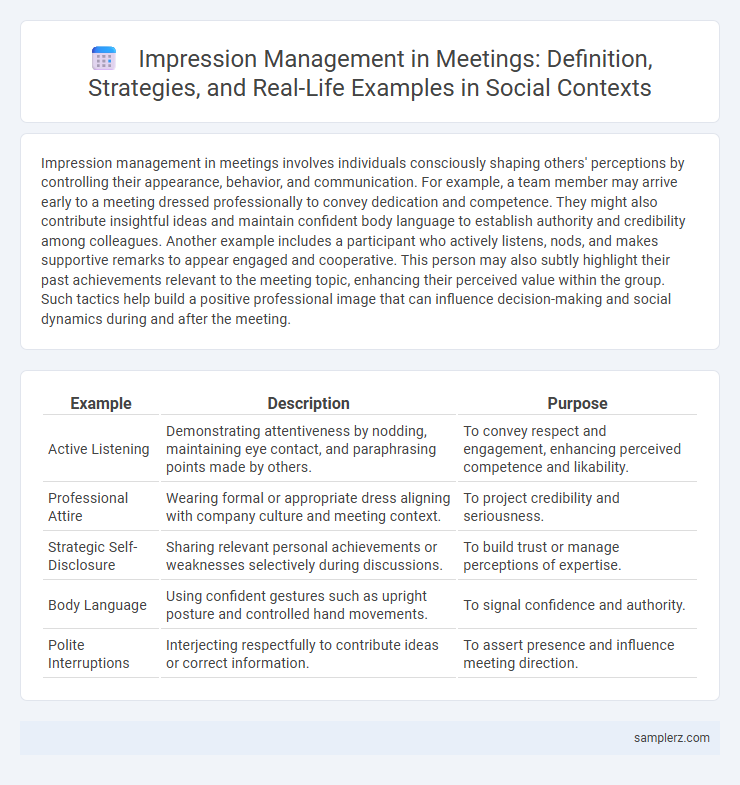Impression management in meetings involves individuals consciously shaping others' perceptions by controlling their appearance, behavior, and communication. For example, a team member may arrive early to a meeting dressed professionally to convey dedication and competence. They might also contribute insightful ideas and maintain confident body language to establish authority and credibility among colleagues. Another example includes a participant who actively listens, nods, and makes supportive remarks to appear engaged and cooperative. This person may also subtly highlight their past achievements relevant to the meeting topic, enhancing their perceived value within the group. Such tactics help build a positive professional image that can influence decision-making and social dynamics during and after the meeting.
Table of Comparison
| Example | Description | Purpose |
|---|---|---|
| Active Listening | Demonstrating attentiveness by nodding, maintaining eye contact, and paraphrasing points made by others. | To convey respect and engagement, enhancing perceived competence and likability. |
| Professional Attire | Wearing formal or appropriate dress aligning with company culture and meeting context. | To project credibility and seriousness. |
| Strategic Self-Disclosure | Sharing relevant personal achievements or weaknesses selectively during discussions. | To build trust or manage perceptions of expertise. |
| Body Language | Using confident gestures such as upright posture and controlled hand movements. | To signal confidence and authority. |
| Polite Interruptions | Interjecting respectfully to contribute ideas or correct information. | To assert presence and influence meeting direction. |
Strategic Self-Presentation in Team Meetings
Strategic self-presentation in team meetings involves deliberately highlighting specific skills and achievements to influence colleagues' perceptions and establish credibility. Participants may emphasize past successes or align their language with team goals to foster trust and collaboration. This intentional impression management enhances their professional image and supports effective team dynamics.
Managing First Impressions with New Colleagues
Maintaining a confident posture, offering a firm handshake, and making consistent eye contact effectively shape positive first impressions with new colleagues. Dressing appropriately to match the company culture signals professionalism and respect, enhancing perceived credibility. Using concise, clear language while actively listening demonstrates competence and fosters trust from the outset.
Using Body Language to Influence Perceptions
Using body language to influence perceptions in meetings involves maintaining open gestures, such as uncrossed arms and consistent eye contact, to convey confidence and approachability. Leaning slightly forward signals engagement and interest, while controlled nodding can encourage agreement and rapport. These nonverbal cues help shape others' impressions, fostering a positive and persuasive presence during professional interactions.
Highlighting Achievements Without Boasting
During meetings, individuals practicing impression management often emphasize their accomplishments by presenting measurable results and specific contributions, ensuring their achievements are clear yet modest. They focus on expressing gratitude for team support and framing successes as collaborative efforts to avoid appearing boastful. This approach fosters a positive reputation while maintaining professionalism and humility.
Demonstrating Active Listening to Build Rapport
Demonstrating active listening in meetings involves maintaining eye contact, nodding, and providing verbal affirmations like "I understand" to show engagement. Paraphrasing key points and asking clarifying questions signal attentiveness and genuine interest in the speaker's message. These behaviors build rapport, foster trust, and enhance collaborative communication among team members.
Adapting Communication Style for Diverse Audiences
Adapting communication style in meetings demonstrates impression management by tailoring language, tone, and gestures to resonate with diverse audiences, enhancing relatability and credibility. For instance, using technical jargon with expert colleagues while simplifying concepts for non-specialists ensures clear understanding and positive perception. This strategic adjustment signals social awareness and respect, fostering trust and cooperation among varied participants.
Navigating Difficult Questions to Maintain Authority
During meetings, successfully navigating difficult questions enhances impression management by demonstrating confidence and expertise. Strategically reframing challenging inquiries allows leaders to maintain authority and steer the discussion constructively. Employing clear, concise responses while acknowledging concerns reinforces credibility and control in professional settings.
Leveraging Humor to Ease Meeting Tension
Leveraging humor in meetings serves as a powerful impression management tactic to reduce tension and foster a collaborative atmosphere. Strategic use of lighthearted jokes or relatable anecdotes creates positive social cues that enhance interpersonal rapport and boost group morale. Demonstrating humor not only showcases emotional intelligence but also positions individuals as approachable and charismatic leaders within professional settings.
Balancing Confidence and Humility in Discussions
Effective impression management in meetings involves balancing confidence with humility by clearly communicating expertise while acknowledging others' viewpoints. Demonstrating confidence through articulate speech and well-prepared data builds credibility, whereas expressing openness to feedback fosters collaboration and trust among participants. This balance enhances professional relationships and drives productive discussions.
Dressing for Success: Nonverbal Impression Management
Dressing for success in meetings involves selecting professional attire that conveys confidence, competence, and credibility, influencing how colleagues and clients perceive an individual. Nonverbal impression management through clothing aligns with organizational culture and audience expectations, enhancing positive judgments and facilitating effective communication. Strategic wardrobe choices, such as tailored suits or polished accessories, function as powerful nonverbal cues that shape social interactions and leadership presence in professional settings.

example of impression management in meeting Infographic
 samplerz.com
samplerz.com